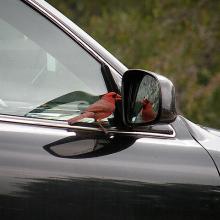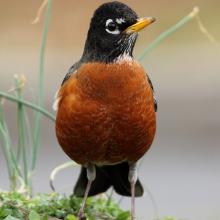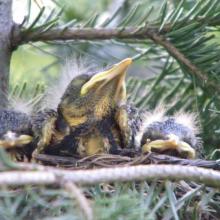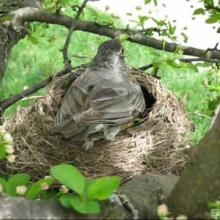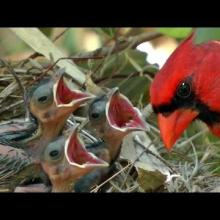

Join BirdNote tomorrow, November 30th!
Illustrator David Sibley and actor H. Jon Benjamin will face off in the bird illustration battle of the century during BirdNote's Year-end Celebration and Auction!
The male American Robin - fiercely territorial - belts out its distinctive cheery song to defend its breeding territory from invasion by other robins. Sometimes, the robin sees its own reflection as an interloper and challenges the “invader” over and over, even to the point of exhaustion or injury. It's called the "battering robin syndrome," although cardinals, mockingbirds, juncos, and other birds do it, too. Closing the curtains or stenciling stars made with Bon Ami paste onto the windows can help.
BirdNote®
American Robin, Valiant Challenger
Written by Frances Wood
This is BirdNote!
[American Robin singing]
This cheery song belongs to the American Robin. Belting out this distinctive message is one way that male robins defend their breeding territories from invasion by other robins. [American Robin singing]
If a vocal warning does not deter an invading bird, a male robin – [as an aside:] and cardinals and mockingbirds do this, too – will fly at the intruder to scare it away. This usually does the trick— unless the “intruder” is the bird’s own image reflected in a window, a hubcap, an outdoor mirror, or some other shiny surface. [flapping at window]
Hour after hour, a robin may fling into or peck at a reflective surface to drive away its assumed invader. Even if something scares the robin away, or it flies off on its own accord, the robin remembers where the reflection appeared and will return again and again to challenge the “invader.” Sometimes it will exhaust itself or even sustain injury in the battle.
If you’re sympathetic to robins – and other songbirds – hopelessly battering themselves, cover the outside of the problem window or remove the reflective surface.
With the “intruder” safely removed, the American Robin will return to singing. A more natural — and safer — method of protecting its breeding territory. [American Robin song.]
I’m Mary McCann. If you’d like to get more ideas for making life easier for birds, knock yourself out with a visit to our website, birdnote.org. [American Robin song.]
###
Song of the American Robin provided by the Macaulay Library of Natural Sounds at the Cornell Lab of Ornithology, Ithaca, New York. Recorded by W.L. Hershberger.
Producer: John Kessler
Executive Producer: Chris Peterson
© 2015 Tune In to Nature.org April 2018/2019 Narrator: Mary McCann
ID#060405AMROKPLU AMRO-02b




